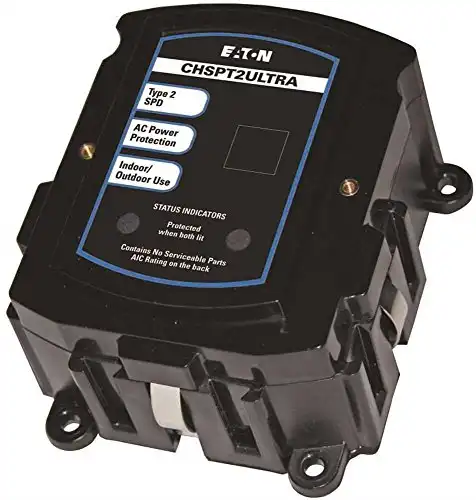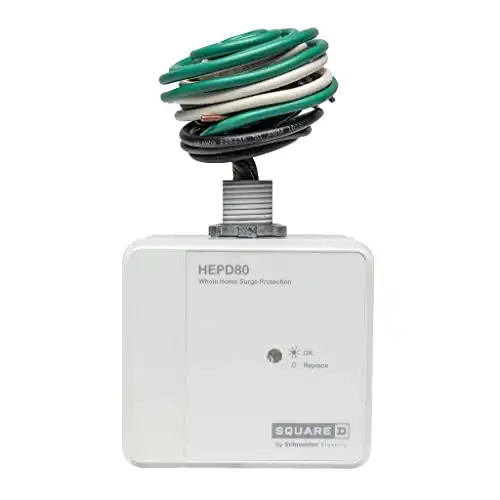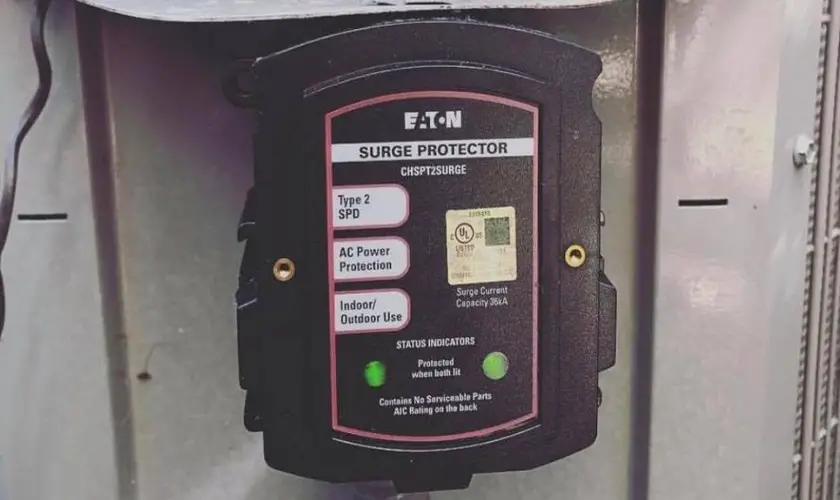
A whole house surge protector is an important device that protects your home appliances and electronics from electrical power surges. Electrical surge damage to your electrical appliances and sensitive electronics costs US households about $1 billion annually. Many aren’t aware that whole-home surge protection is an option and how inexpensive this protection can be.
We’ve tested and reviewed the top-rated products to bring you the best whole-house surge protector. Here are our favorites for you.
Our Favorite Whole House Surge Protector
EATON CHSPT2ULTRA Ultimate Surge Protection 3rd Edition
This whole house surge protector works with any manufacturer brand electrical panel. The quick-connect design makes it easy to install. The LED indications of power status are beneficial. This product is made with high-quality standards and is very easy to use.
Surge protectors are designed to protect your electronics from power surges, which is why having one is important. This surge protector is rated at 108,000 amps, making it a good option for protecting your devices from lightning damage.
It’s suitable for indoor or outdoor use so you can install it on electrical panel boxes outside.
The installation is straightforward. All you need are two wires, which you will connect to a double-pole breaker. One wire goes to the ground and one to neutral. The breaker can be installed anywhere in the panel, but keeping the cables from the surge protector short and without any kinks is important. Surges always look for a way to the ground, so you are unlikely to have anything closer than the surge protector.
Leviton 51120-1 120/240 Volt Panel Protector, 4-Mode Protection
The Leviton 51120-1 (120/240-volt AC) surge protection panel diverts voltage surges from electronic equipment. The protection panel is intended for single-phase installations in residential and apartment complexes at the service entrance or other branch locations. It’s ideal for residential and light commercial enterprises where high-energy, high-voltage transients require protection.
A real-time diagnostic visual indicator light displays the power and suppression status for the protected phase. This means you can see if there is a power surge and how much suppression is happening. It also assures the safety of delicate equipment. If something goes wrong with your product, it comes with a limited lifetime product warranty. Your connected equipment is also covered for up to $25,000 in residential applications.
Leviton designed this surge protection device to protect your entire home from high voltage spikes. It’s ideal for safeguarding household appliances, computers, LCDs or LED TVs, and PDA products. The surge protector meets the 3rd edition of the UL 1449 standard. A real-time visual indicator shows each protected phase’s power and suppression status.
If there is a power surge and your Leviton surge protector fails, they will replace or repair any properly connected equipment for up to $25,000. This warranty covers electrical transients on AC power or communication lines, including those caused by indirect lightning. The warranty is included with the purchase of the surge panel.
The 51120-1 surge protective device is easy to install in frame construction environments. It comes in a J-Box metal enclosure that has pre-punched standard-size knockouts. This makes it easy to connect to existing branch panels.
Square D – HEPD80 Whole House Surge Protection Device
The PowerPact H-, J-, and L-frame circuit breakers are designed to protect your home’s electrical system from damage caused by overloads or short circuits. The H- and J-frame circuit breakers are available with either thermal-magnetic or Micrologic electronic trip units.
The PowerPact with Micrologic circuit breakers set the bar with easy access to energy management. Metering integration enhances their protective capabilities. For the first time, users of Schneider Electric’s products can now monitor energy from 15A, improving performance in a tiny device.
The HEPD80 is an excellent investment to safeguard your home’s main electrical panel. The surge protector will also assist in keeping you safe, even from spikes caused by an emergency power generator.
Modern furnaces, washing machines, clothes dryers, stoves, dishwashers, microwaves, and water heaters all feature electronic circuit boards vulnerable to power surges. We safeguard our TVs, DVD Players, Computers, and other electronic gadgets that cost less than our major household appliances daily.
The installation of the HEPD80 is straightforward (if you have any electrical experience). FYI: This work is not for the faint of heart and should be done by a professional electrician.
This unit has a high maximum surge amps rating (80,000 amps). If you ever experience a surge with this much power, it will almost certainly be due to a direct lightning strike, although you will still suffer some damage. This device would offer the same level of protection as any other high-end surge protector.
The HEPD80 has two green lights that tell you whether it’s working correctly right away. If one (or both) of the green lights are off, there is a problem. You might have a tripped circuit breaker, lost the incoming power source, or your main electrical panel is damaged, and your surge protective device is doing its job and needs to be replaced.
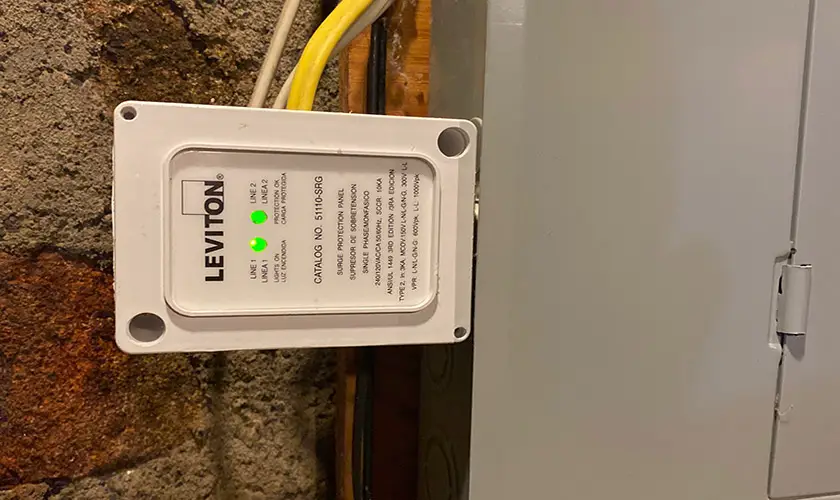
What is a Whole House Surge Protector
A whole-home surge protector protects each circuit in your house. The whole house surge protector monitors all circuits and any excess voltage or electrical surge before it reaches your expensive appliances and devices rather than installing power strips or extension cords in your home.
Types of Surge Protectors
There are different types of surge protection devices. When choosing the best one for your home, you need to figure out which type it is.
Type 1
Type 1 devices offer the best protection from external sources. They also protect against low-power surges. These types of surges are not usually harmful.
These surge protectors are installed at the electrical service meter base before the main breaker box. This is called the “line side,” so only safe levels of electricity can flow into the home.
Installation requires that the power to the home be turned off while work is done. A qualified electrician must perform the installation, which can increase costs significantly.
Type 2
Type 2 whole house surge protection devices (the ones we feature in this article) are the most popular surge protectors. They can be installed inside the main breaker panel or a sub panel. Installing them can be done by anyone who is knowledgable DIY with some electrical experience. However, we recommend calling in a licensed electrician.
Type 2 surge devices can protect a single circuit or all circuits in an electrical panel, depending on how installed, which is why a knowledgeable electrician is handy.
The National Fire Protection Association (NFPA) has proposed installing all new homes with a Type 1 or Type 2 device. For existing homes, any replacement service panel would include one.
Type 3
Strip surge protectors or receptacle surge protectors are a popular, low-cost way to protect your devices from power surges. They plug into any household outlet and typically have 4-6 additional outlets. This is a convenient way to protect devices like TVs, computers, or gaming consoles.
These gadgets are technically called surge arresters. Type 1 and Type 2 surge protectors absorb excess power. Surge protectors can stop some damage but are not 100% effective.
Things to Consider When Buying Whole House Surge Protection
UL Certification
UL is an independent organization that tests and certifies products for safety. The current standard for surge-protection devices is UL 1449 (3rd edition). If a whole house surge protection device is listed as a Transient Voltage Surge Suppressor (TVSS), it will be labeled as such on the device.
UL 1449 is a standard that covers how quickly a surge protector responds and how much current it takes to trip it. A surge protector must meet the requirements for up to 15 consecutive tests to pass.
Devices may also be Canadian Standards Association (CSA) rated. This is a highly regarded global organization, and certification underlines the high safety standards of the device.
Continuous Operating Voltage Ratings
The nominal voltage provided to residential homes in the US is 110/120 volts. In many other countries, it is 220/240 volts.
The maximum continuous operating voltage (MCOV) is the amount of voltage the surge protector will allow without tripping. So the MCOV is slightly higher, usually between 15 percent and 20 percent. For example, a 120-volt surge protector with a 20 percent margin would have an MCOV of 144 volts.
Voltage and Surge Protection Ratings
A lightning strike can deliver 300 million volts (30,000 Amps) into a home’s electrical system. The UL and CSA’s voltage protection rating is not always prominently featured in product details.
The minimum amount of amps you need to protect your home is 10,000. But it depends on the device type. The best whole-house surge protectors usually have a limit of 30,000 amps or more. This should be enough to protect your home from the worst storms or power problems.
NEMA Enclosure Type
The National Electrical Manufacturers Association (NEMA) has a rating system for electrical device enclosures. This system specifies the environments where a particular device can be installed and used safely.
There are two types of NEMA ratings:
- Protection the enclosure offers to equipment inside, against dirt, dust, etc.
- Protection the enclosure offers to people who might come into contact with it.
Whole-house surge protectors vary widely in quality, style, and price. NEMA 1 is the lowest rating, indicating that a facility is intended for indoor use and offers only minimal shock protection. You may use a NEMA 4X-rated device indoors or outside.
Additional Features
If there is a surge, it is unlikely that your protection will be gone entirely. But if there are many surges, your protection may not work. If the surge protector works well up to that point, you may not even know there is a problem. Most basic whole-house surge protection devices have an LED indicator light to show whether or not it is working.
Some more complex surge protectors have additional indicator lights to show when a surge has happened. Others have alarms that people can hear. People with smart home technology can choose surge protectors that send information about surges to their smartphones or tablets.
Surge Protector Installation
Type 1 whole-house surge protectors are fitted between the external utility cable and the main breaker panel. This installation needs to be done by a certified electrical contractor, or it might not be safe and could void your home insurance if there is a fire or other problem.
Type 2 whole-house surge protectors can be installed by anyone with basic electrical knowledge and skills. The surge protector device connects to the electrical panel through a 240v breaker. The amperage can change. Some call for connecting to a 240v 50amp breaker, while others call for a 240v 15Amp breaker. You should consult or hire a licensed electrician if you have doubts or uncertainty.
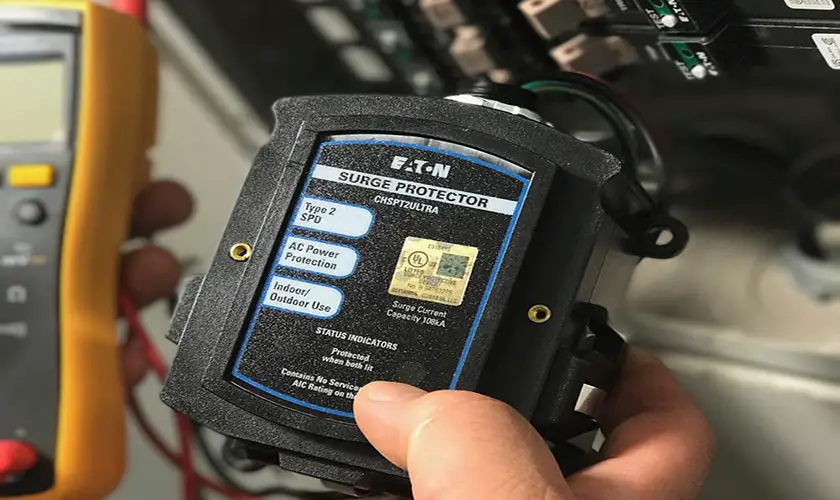
What is a Power Surge?
A power surge is an increase in electricity, just as the name implies. It’s a rapid voltage spike in your house’s electrical system that exceeds the normal flow rate. Power surges can damage appliances and electronics connected to your walls and cause electric fires if you use faulty electrical outlets or extension cords. Lighting strikes generally cause power surges.
According to the Insurance Information Institute, lightning strikes homes in the United States approximately 20 million times yearly, causing about $1 billion in property damage. These lightning strikes might destroy electrical devices and appliances inside your house. There are more than 77,000 annual claims to US insurance companies due to lightning damage. Each claim, on average, was worth around $12,000.
Lightning strikes and sudden power surges caused by artificially generated electrical currents are covered under a standard homeowner’s insurance policy.
What Causes a Power Surge?
A variety of factors can cause electrical surges. Switching on a hair dryer might produce 5-10 volts. Where lightning striking a transformer can generate thousands of volts. The following are the most common causes of electrical surges in your house:
- When the electricity goes out and restarts – as with a vacuum or air conditioner turns on or off.
- A tree or animal comes into contact with a power line or transformer.
- When there is a quick return of electricity after an outage.
- When your power provider shifts from one electrical grid to another.
- Your home or electrical equipment is struck by lightning.
Internal power surges are the most frequent and happen hundreds of times daily. The refrigerator, dryer and air conditioners are usual offenders, although even electronic gadgets can create internal electrical surges, such as plugging in a phone to charge.
How to Prevent Power Surges
Establishing an initial line of defense is the most effective way to avoid power surges. Although you can’t prevent electrical storms, you may take steps to safeguard your computing equipment and appliances.
Don’t Overload Electrical Circuits
You may have too many things on one circuit if more than two appliances are plugged into one outlet. If this is the case, try moving some of those appliances to other outlets in your home.
Unplug Appliances You’re Not Using
It would be best if you unplug electronic devices and appliances when not in use is one of the simplest methods to prevent them from being damaged by electrical surges. There’s a chance that a surge could go through the device or equipment if you leave it plugged in. You’ll probably find dozens of unnecessary machines plugged into your home.
Perform Electrical Upgrades in Older Homes
An electrical wiring upgrade might be necessary if you live in an older home, like one built before the 1980s. This could be a problem if you have many appliances or often trip breakers or blow fuses. You might also have issues with lights that flicker or dim when a large appliance is in use.
Install a Whole Home Surge Protector
A whole home surge protector protects your electronic devices and major appliances from surges in electricity. This is done by routing the electricity through the surge protector instead of through your devices. In the event of a surge, the surge protector will take the brunt of the voltage, protecting your devices.
How a Whole House Surge Protector Works
A whole-house surge protector is connected to your electrical system and protects the entire house in the event of power spikes. The whole home surge protector blocks or grounds electricity surges so that your appliances and expensive electronics are not harmed.
The most common way to ground a surge protector is by connecting it to your home’s grounding system. The surge protector won’t function correctly if you don’t connect it to your house’s ground wire system. When installing the whole-house suppressor, have your electrician check out your home’s grounding system if you’re unsure.
A surge protection system that works on the entire house can stop 40,000 amps or more surges. Audible alarm or indicator light signals when a surge has been halted are desirable features. If required, you might consider whole-house surge protection systems to safeguard phone, cable, and internet lines in some cases.
When properly installed, multi-level surge protection systems can protect you against surges from the outside and inside of your house. Ensure your entire home surge protection is completed between the electric meter, the power lines that enter your property, and between the electric meter and the circuit breaker box.
Frequently Asked Questions
How Much Does a Whole House Surge Protector Cost?
A whole home surge protector typically costs between $100 and $300, plus professional whole house surge protector installation. The average cost will vary depending on the protection type you need and the size of your home.
How to Wire a Whole House Surge Protector?
If installing a whole house surge protector, you will need to wire it into your home’s electrical panel. A professional licensed electrician can do this. The surge protector should mount to the outside of the panel or within eyesight so you can see the LED indicator lights.
Typically, the whole house surge protector wires into a 240v 50-amp breaker and the neutral bar. Installation methods and breaker sizing may vary, so check the manufacturer’s instructions for your specific instructions.
Can a Whole House Surge Protector Be Installed Outside?
Most whole house surge protectors are not weatherproof and should not be installed outside without a weather protection cover. If installing your whole house surge protector outside, use an electrical conduit and a waterproof enclosure with an access cover.
How Long do Whole House Surge Protectors Last?
How long a whole house surge protector lasts depends on the device’s quality and how frequent power surges occur. Typically, you can expect a whole home surge protection device to last 5 to 10 years. However, our research found that an SPD can last for 2 to 3 years in areas with frequent power surges or outages.
The kA rating is a value that tells you how long the surge protector will last. Increasing the kA rating of the surge suppressor does not improve its protection performance. The higher the kA rating, the move voltage the surge protection device can absorb. We recommend a minimum of 10 kA rating.
Our best overall pick EATON Ultimate Surge Protection, has a 108kA rating and Is suitable for outdoor use.
Conclusion
Whole home surge protectors are a must-have for any homeowner. They safeguard your large appliances, electronics, and other devices against unexpected power surges that can occur when the weather is bad or when there is an electrical problem in your area.
A whole house surge protector will save you from costly repairs or replacements down the road and could also prevent a fire in your home. We recommend buying a whole house surge protector to protect your expensive devices and household appliances.
Get FREE estimates from licensed electricians in your area today. Whether you need to replace an outlet, hang a ceiling fan, a new electrical panel, or repair wiring, We Can Help!


